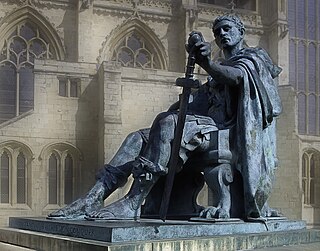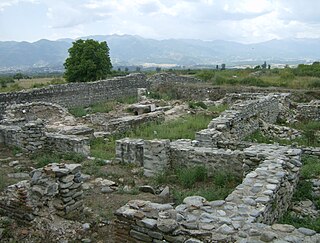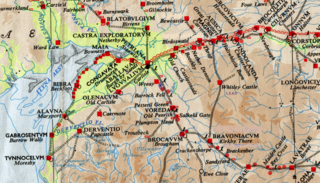
Marcus Aurelius Antoninus, better known by his nickname Caracalla, was Roman emperor from 198 to 217 AD. He was a member of the Severan dynasty, the elder son of Emperor Septimius Severus and Empress Julia Domna. Proclaimed co-ruler by his father in 198, he reigned jointly with his brother Geta, co-emperor from 209, after their father's death in 211. His brother was murdered by the Praetorian Guard later that year under orders from Caracalla, who then reigned afterwards as sole ruler of the Roman Empire. Caracalla found administration to be mundane, leaving those responsibilities to his mother. Caracalla's reign featured domestic instability and external invasions by the Germanic peoples.

Publius Septimius Geta was Roman emperor with his father Septimius Severus and older brother Caracalla from 209, when he was named Augustus like his brother, who had held the title from 198. Severus died in 211, and although he intended for his sons to rule together, they proved incapable of sharing power, culminating with the murder of Geta in December of that year.

Julia Domna was Roman empress from 193 to 211 as the wife of Emperor Septimius Severus. She was the first empress of the Severan dynasty. Domna was born in Emesa in Roman Syria to an Arab family of priests of the deity Elagabalus. In 187, she married Severus, who at the time was governor of the Roman province of Gallia Lugdunensis. They had two sons, Caracalla and Geta. A civil war over the Roman throne broke out in 193, and shortly afterwards Severus declared himself emperor. The war ended in 197 with the defeat of the last of Severus's opponents.

Eboracum was a fort and later a city in the Roman province of Britannia. In its prime it was the largest town in northern Britain and a provincial capital. The site remained occupied after the decline of the Western Roman Empire and ultimately developed into the present-day city of York, in North Yorkshire, England.

The Arch of Septimius Severus at the northwestern end of the Roman Forum is a white marble triumphal arch dedicated in 203 AD to commemorate the Parthian victories of Emperor Septimius Severus and his two sons, Caracalla and Geta, in the two campaigns against the Parthians of 194-195 and 197–199. After the death of Septimius Severus, his sons Caracalla and Geta were initially joint emperors. Caracalla had Geta assassinated in 212; in the practice now known as damnatio memoriae, Geta's memorials were destroyed and all images or mentions of him were removed from public buildings and monuments. Accordingly, Geta's image and inscriptions referring to him were removed from the arch.

Britannia Inferior was a new province carved out of Roman Britain probably around AD 197 during the reforms of Septimius Severus although the division may have occurred later, between 211 and 220, under Caracalla. The removal of the governors in Londinium from control over the legions guarding Hadrian's Wall was aimed at reducing their power, given Clodius Albinus's recent bid to become emperor. The province was probably formalised around 214 by Severus's son Caracalla.

Rough Castle Fort is a Roman fort on the Antonine Wall roughly 2 kilometres south east of Bonnybridge near Tamfourhill in the Falkirk council area, Scotland. It is owned by the National Trust for Scotland.

Arbeia was a large Roman fort in South Shields, Tyne & Wear, England, now ruined, and which has been partially reconstructed. It was first excavated in the 1870s. All modern buildings on the site were cleared in the 1970s. It is managed by Tyne and Wear Museums as Arbeia Roman Fort and Museum.

The Severan Tondo or Berlin Tondo from c. 200 AD is one of the few preserved examples of panel painting from Classical Antiquity, depicting the first two generations of the imperial Severan dynasty, whose members ruled the Roman Empire in the late 2nd and early 3rd centuries. It depicts the Roman emperor Septimius Severus with his wife, the augusta Julia Domna, and their two sons and co-augusti Caracalla and Geta. The face of one of the two brothers has been deliberately erased, very likely as part of damnatio memoriae.

Pons Aelius, or Newcastle Roman Fort, was an auxiliary castra and small Roman settlement on Hadrian's Wall in the Roman province of Britannia Inferior, situated on the north bank of the River Tyne close to the centre of present-day Newcastle upon Tyne, and occupied between the 2nd and 4th centuries AD.
Petuaria was originally a Roman fort situated where the town of Brough in the East Riding of Yorkshire now stands. Petuaria means something like 'quarter' or 'fourth part', incorporating the archaic Brythonic *petuar, 'four'.

Nicopolis ad Nestum or Nicopolis ad Mestum is a ruined Roman town in the province of Thracia (Thrace) near to the modern village of Garmen on the left bank of the Mesta river, in Garmen Municipality, Bulgaria. Although "ad Nestum" is the more commonly used alternative, "ad Mestum" is the correct form of the name during the Roman period.
Cohors secunda Gallorum veterana equitata was a mixed infantry and cavalry regiment of the Auxilia corps of the Imperial Roman army. It was stationed, in the 2nd and 3rd centuries, in a fort near Hadrian's Wall in Britain.

Aballava or Aballaba was a Roman fort on Hadrian's Wall, between Petriana (Stanwix) to the east and Coggabata (Drumburgh) to the west. It is about one and a half miles south of the Solway Firth, and its purpose was to guard the south end of two important Solway fords, the Peat Wath and the Sandwath, which were also to become favourite routes for medieval border raiders.

Bewcastle Roman Fort was built to the north of Hadrian's Wall as an outpost fort possibly intended for scouting and intelligence. The remains of the fort are situated at the village of Bewcastle, Cumbria, 7 miles (11 km) to the north of the Roman fort at Birdoswald, on Hadrian's Wall.
The gens Septimia was a minor plebeian family at ancient Rome. The gens first appears in history towards the close of the Republic, and they did not achieve much importance until the latter half of the second century, when Lucius Septimius Severus obtained the imperial dignity.
The Cohors VI Nerviorum was an auxiliary unit of Roman Army Cohors quinquagenaria peditata type attested in the Roman province of Britannia from the second century to the early fifth century AD.
Cohors PrimÆ Ælia Dacorvm was an infantry regiment of the Auxilia corps of the Imperial Roman army. It was first raised by the Roman emperor Hadrian in the Roman province of Dacia not later than AD 125 and its last surviving record dates c. 400. It was deployed, for virtually its entire history, in forts on Hadrian's Wall on the northern frontier of Britannia province.

The Roman Fort of Carpow was situated at the confluence of the rivers Tay and Earn in what is now Scotland.

Castra Exploratorum was a Roman fort and associated substantial civil settlement now in the grounds of Netherby Hall, Cumbria. It was first built by Agricola during his conquest of the north in around 80 AD.


















